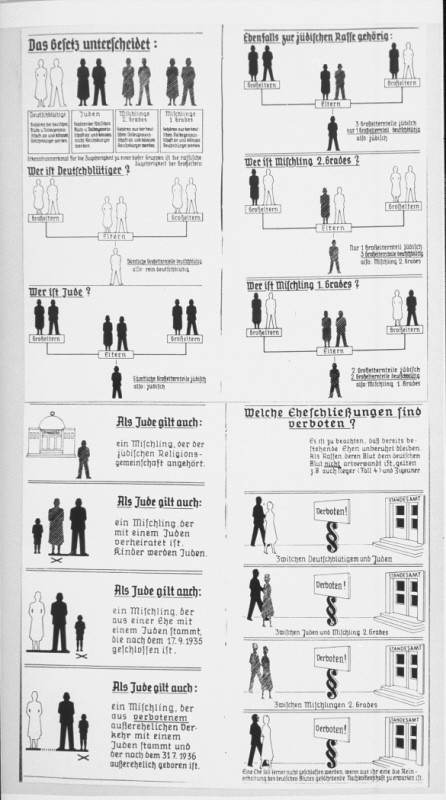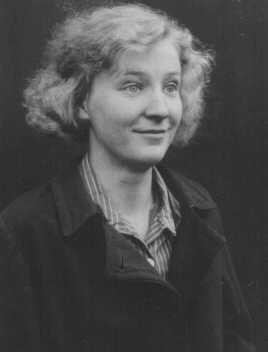
The Biological State: Nazi Racial Hygiene, 1933–1939
Nazism was “applied biology,” stated Hitler deputy Rudolf Hess. During the Third Reich, a politically extreme, antisemitic variation of eugenics determined the course of state policy. Hitler’s regime touted the “Nordic race” as its eugenic ideal and attempted to mold Germany into a cohesive national community that excluded anyone deemed hereditarily “less valuable” or “racially foreign.”
Public health measures to control reproduction and marriage aimed at strengthening the “national body” by eliminating biologically threatening genes from the population. Many German physicians and scientists who had supported racial hygiene ideas before 1933 embraced the new regime’s emphasis on biology and heredity, the new career opportunities, and the additional funding for research.
Hitler’s dictatorship, backed by sweeping police powers, silenced critics of Nazi eugenics and supporters of individual rights. After all educational and cultural institutions and the media came under Nazi control, racial eugenics permeated German society and institutions. Jews, considered “alien,” were purged from universities, scientific research institutes, hospitals, and public health care. Persons in high positions who were viewed as politically “unreliable” met a similar fate.
The Battle for Births

Echoing ongoing eugenic fears, the Nazis trumpeted population experts’ warnings of “national death” and aimed to reverse the trend of falling birthrates. The Marital Health Law of October 1935 banned unions between the “hereditarily healthy” and persons deemed genetically unfit. Getting married and having children became a national duty for the “racially fit.” In a speech on September 8, 1934, Hitler proclaimed: “In my state, the mother is the most important citizen.”
Eugenicists had expressed concerns about the effects of alcohol, tobacco, and syphilis. The Nazi regime sponsored research, undertook public education campaigns, and enacted laws that together aimed at eliminating “genetic poisons” linked to birth defects and genetic damage to later generations. In 1936 the Reich Central Office for Combating Homosexuality and Abortion was established to step up efforts to prevent acts that obstructed reproduction. In a 1937 speech linking homosexuality to a falling birthrate, German police chief Heinrich Himmler stated: “A people of good race which has too few children has a one-way ticket to the grave.”
The Mass Sterilization Program

On July 14, 1933, the Nazi dictatorship fulfilled the long-held dreams of eugenics proponents by enacting the Law for the Prevention of Offspring with Hereditary Diseases (“Hereditary Health Law”), based on a voluntary sterilization law drafted by Prussian health officials in 1932. The new Nazi law was coauthored by Falk Ruttke, a lawyer, Arthur Gütt, a physician and director of public health affairs, and Ernst Rüdin, a psychiatrist and early leader of the German racial hygiene movement. Individuals who were subject to the law were those men and women who “suffered” from any of nine conditions assumed to be hereditary: feeblemindedness, schizophrenia, manic-depressive disorder, genetic epilepsy, Huntington’s chorea (a fatal form of dementia), genetic blindness, genetic deafness, severe physical deformity, and chronic alcoholism.
Special hereditary health courts lent an aura of due process to the sterilization measure, but the decision to sterilize was generally routine. Nearly all better-known geneticists, psychiatrists, and anthropologists sat on such courts at one time or another, mandating the sterilizations of an estimated 400,000 Germans. Vasectomy was the usual sterilization method for men, and for women, tubal ligation, an invasive procedure that resulted in the deaths of hundreds of women.
Views from Abroad
International reaction to the Nazi sterilization law varied. In the United States, some newspaper editors noted the mass scale of the policy and feared that “Hitlerites” would apply the law to Jews and political opponents. In contrast, American eugenicists viewed the law as the logical development of earlier thinking by Germany’s “best specialists” and not as “the hasty improvisation of the Hitler regime.”
In the 1930s, leading American and British geneticists increasingly criticized established eugenic organizations for freely mingling prejudices with a dated and simplistic understanding of human heredity. At the same time, sterilization gained support beyond eugenic circles as a means of reducing costs for institutional care and poor relief. Sterilization rates climbed in some American states during the Great Depression, and new laws were passed in Finland, Norway, and Sweden during the same period. In Great Britain, Catholic opposition blocked a proposed law. Nowhere did the numbers of persons sterilized come close to the mass scale of the Nazi program.
The Segregation of Jews
The sterilization of ethnic minorities defined as “racially foreign” was not mandated under the 1933 law. Instead, the “Blood Protection Law,” announced in Nuremberg on September 15, 1935, criminalized marriage or sexual relations between Jews and non-Jewish Germans. Soon after, Nazi leaders took biological segregation a step further, privately discussing the “complete emigration” of all Jews as a goal. After the incorporation of Austria in March 1938 (the Anschluss), SS officer Adolf Eichmann coordinated the forced emigration of tens of thousands of Austrian Jews. The Nazi-organized attacks on German and Austrian Jews and Jewish property of November 9–10, 1938—Kristallnacht—convinced many Jews remaining in the Reich that leaving was their only option for survival.
Critical Thinking Questions
- What is the appropriate relationship between a government and the medical profession?
- What is the appropriate relationship between ideology and the medical profession?
- How can knowledge of the events in Germany and Europe before the Nazis came to power help citizens today respond to threats of genocide and mass atrocity in the world?

